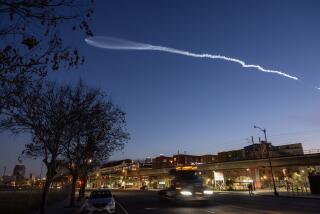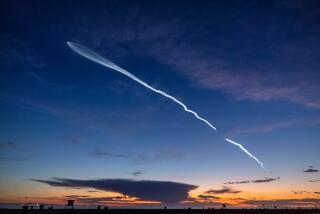Science / Medicine : The...
WASHINGTON â The Pentagon is testing beryllium, a highly toxic substance linked to cancer and lung disease, as a fuel for space-based interceptor missiles that would be deployed under the âStar Warsâ missile defense program.
Although beryllium previously has been rejected as a rocket fuel, partly because of health concerns, military officials said its use in Star Wars would pose fewer risks because the interceptor missiles would be fired in space after being carried into orbit by other rockets.
Even so, critics contend that the new fuel would pose a serious health hazard if one of the ground launches fails, causing the interceptor missiles to explode and releasing a poisonous cloud of beryllium oxide above the launch site.
Environmental objections to use of beryllium fuel could deal another blow to the embattled Star Wars program, said retired Rear Adm. Eugene J. Carroll Jr., deputy director of the Center for Defense Information, a Washington-based watchdog group.
âYouâve got the potential of bringing a whole new element of objectionâ to Star Wars, said Carroll, an outspoken opponent of the program, known officially as the Strategic Defense Initiative.
The huge booster rockets that would carry the beryllium-powered interceptors into space probably would be launched from Vandenberg Air Force Base in Santa Barbara County or Cape Canaveral in Florida.
Test firings of beryllium rocket motors have already been conducted at a Morton-Thiokol installation at Elkton, Md. Additional tests are expected to begin within the next two years in a specially designed $4.5-million chamber at the Air Force Astronautics Laboratory at Edwards Air Force Base near Lancaster, military officials said.
The Pentagonâs Strategic Defense Initiative Organization has chosen a beryllium-hydrogen compound called beryllium hydride as the leading candidate to fuel space-based interceptors, said Walt Dyer, SDIO program manager for interceptor components.
A lightweight and exceptionally durable metal that is used in a number of industrial products, beryllium causes a serious lung disease known as berylliosis in chronically exposed workers and is a suspected cancer-causing substance.
Aside from beryllium hydride, alternative candidate fuels are beryllium alone--which is not as efficient as beryllium hydride--and powdered aluminum, which is much less toxic than beryllium.
Under one facet of the Star Wars missile defense program, initiated by former President Ronald Reagan, hundreds, perhaps thousands, of interceptors would be placed in permanent orbit to shoot down enemy missiles.
Although the Pentagon is proceeding with testing of beryllium fuel, the future of Star Wars appears uncertain. SDI was a priority of the Reagan Administration, but this year the program received reduced funding of $3.7 billion from an increasingly skeptical Congress.
Faced with growing pressure to cut the military budget, Defense Secretary Dick Cheney said recently that the program must continue to explore defensive technologies at least until 1994, when the President is scheduled to decide whether to deploy a missile shield.
Beryllium hydrideâs major asset is its high efficiency. Dyer said the amount needed as a missile propellant would weigh 40% less than other potential fuels.
Nonetheless, he said, several hundred pounds of beryllium fuel could be contained in the interceptors boosted into space in a single launch.
Dyer said that the Pentagonâs SDIO unit has not decided how many launches would be needed to put the entire defensive shield into orbit or how many interceptors would be included in each launch. The total number of space-based interceptors is classified as a military secret.
Independent authorities, however, estimate that scores of booster rocket launches would be necessary if the program is carried out.
The propellant weight reduction would be âextremely important . . . since there would be lots of these space-based interceptors,â Dyer said. He said the weight issue âhas been the driving considerationâ in making beryllium hydride the militaryâs first choice for interceptors.
In a recent interview, Dyer said public safety would not be jeopardized by the use of beryllium.
Beryllium hydride fuel would be fired only in space, Dyer said, and it will not be selected unless studies show that areas around a launch site would not be endangered by a toxic cloud should the booster rocket explode or catch fire during launch.
The Pentagon will evaluate worst-case accident scenarios to âdetermine over what area the cloud would land and . . . be sure that that is an unpopulated area,â Dyer said. âWe believe that we can safely utilize these fuels.â
Under Air Force rules, all launches at Vandenberg are conducted when winds are blowing out to sea. Air Force officials also plot a âtoxic hazard corridorâ before each launch to define the area that could be exposed to falling debris or toxic vapors in a rocket explosion, base spokesman Gary Morey said. A launch is postponed if the corridor includes populated inland areas.
Data provided by the National Aeronautics and Space Administration shows that 5% to 10% of unmanned civilian and military launches fail.
The four major rocket families--Titan, Delta, Atlas-Centaur and Scout--have a combined success rate of 92.6%, with 38 failures in 517 launches since 1960, according to NASA. The failures ranged from rockets that deviated from their designated courses to launches that blew up.
Members of two Washington-based scientific and environmental groups said the use of beryllium fuel on the scale contemplated by the military would be extremely dangerous, given the probability of a launch failure.
âItâs quite likely that in the process of deploying space-based interceptors, youâre going to have at least one launch vehicle failure that could result in the release of significant amounts of beryllium,â said John E. Pike, associate director for space policy of the American Federation of Scientists.
âGiven the probability of a launch failure,â he said, âitâs an unacceptable risk.â
Added Jim Werner, an environmental engineer for the Natural Resources Defense Council, an environmental group: âThe benefits of this program, it seems to me, are dubious at best but the risks are very real.â
Studies by the military of the hazard posed by beryllium fuel to people located on and off the base after a launch failure are yet to be completed. Lompoc, a community of more than 30,000 residents, is about 10 miles from the baseâs launch areas, although some homes are closer.
Safety guidelines set by the American Conference of Governmental Industrial Hygienists, a leading occupational safety group, indicate that under conditions of chronic exposure, beryllium is more harmful at low concentrations than many better-known poisons, including other toxic rocket fuels.
The groupâs occupational limit for airborne beryllium is 100 times stricter than for arsenic; 50 times more stringent than for hydrazine, a common liquid rocket fuel, and about 25 times more stringent than for methyl isocyanate, the poison gas that killed more than 3,400 people in Bhopal, India, five years ago.
These comparisons, however, apply to routine low-level exposures on the job. Most beryllium illness has resulted from such repeated exposures. Some toxic gases would be more likely than beryllium to cause severe illness or death in a single large dose such as might occur in a catastrophic rocket launch accident.
Berylliosis, the disease caused by beryllium exposure, causes the lungs to become more rigid, impairing breathing and, in extreme cases, resulting in suffocation. Victims may suffer heart failure from the stress of pumping blood through lungs that have lost their normal elasticity.
How Space-Based Interceptors Would Work
A tiny, rocket-propelled missile hurtles toward a Soviet ICBM in this artistâs conception of a space-based interceptor as defined by Martin-Marietta. Under the space-based interceptor theory, carrier vehicles (CVs) would house a quantity of the interceptor missiles. A tracking system alerts the CV that a missile is approaching and interceptors are fired. The missile, which might be powered by beryllium hydride, would maneuver to physically collide with the ICBM. The interceptor would have no warhead, but would use the tremendous velocity of the collision to destroy the enemy missile.
Alan C. Miller reported from Washington and Myron Levin from Chatsworth.






